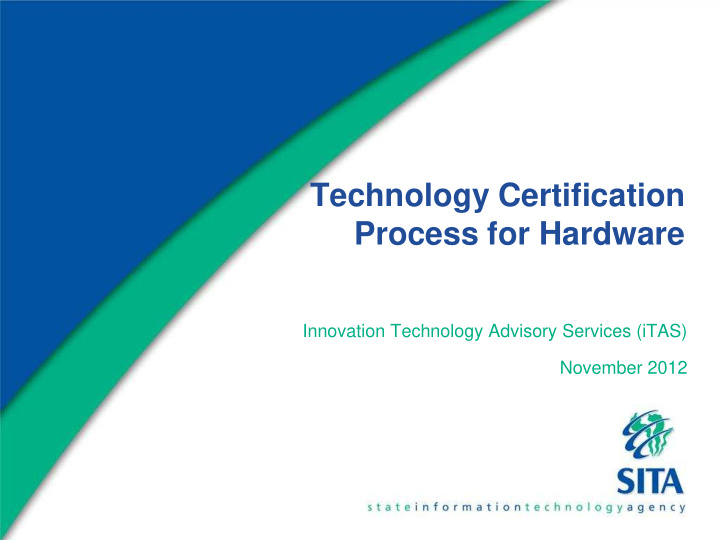



Technology Certification Process for Hardware Innovation Technology Advisory Services (iTAS) November 2012
Introduction • Separate product certification from transversal tenders/contracts • Based on existing SITA hardware evaluation process • OEMs take initiative to certify products with SITA • Products are formally certified, put on database • Government can procure these via tender or RFQ • Requirements: – OEM accreditation letter: submit with bid by partners • Use pro forma OEM letter in bid doc – SITA/OEM Memorandum of Understanding (MOU) • Definitions: – OEM or brand legal entity or delegate (e.g. Distributor) 2
Product certification • OEM-focussed – OEMs submit products for certification – OEM commit to enable quality solutions for Government • Partners (bidders) certified and accredited by OEM – Only related to product offering, not SITA/Government criteria – Certification per category/level (e.g. Servers vs. consumables) – Certified partners allowed to offer any product in a category – Categories informed by Product Certification Process • Certified products entered in a Product Database for reference by all role players – Product certification is not constrained by Tender cycles or limitations. Also, new technologies can be added as required. 3
Split accreditation processes • Research client requirements • Bid conditions • Technical specifications • RFQ/Bid evaluation • Accreditation of ICT (incl. Fin, BEE, Solution) technologies and products • Supplier accreditation • Deployment guides • Engagement model • Product catalogue • Supplier database • Contract management
Certify Goods Certify Suppliers & Services Acquisition DPSA Confirm requirement Tech Spec Departments Bid document (tender) TU4 Approve TU3 transversal Continuous TU2 Requirement Conditions TU1 product (Business-centric) Solution certification Tech Spec Financial Research, Update specs BEE Product Products iTAS Database Business Case Procurement Portal SITA SCM RFQ Tender/Contract 1 Publish 2 Evaluate 3 Award Fully working solution 4 Maintain OEM 5 Monitor Supplier database SITA- Accredit registered Train Manufacturing and SITA monitor Empower approved Support Requirements / Products / OEMs Supplier / Distributor Clients / End Users
High-level certification process • Capture client requirements in detail spec (SITA + Government) • Ratify and publish detail spec (GITOC + SITA) • OEM completes spec, submits products and info to SITA • Evaluate products according to spec (SITA) • Certify compliant products (SITA) • Update and maintain product database (SITA) 6
High-level acquisition process • OEM informs and empowers partners in terms of certified products • SITA publishes transversal bid for required product types • OEM accredits partners for supply (formal letter per partner) • Partners submit product lists and pricing to SITA • Partners are accredited via SITA bid evaluation process • Partners market and supply products to Government 7
OEM conditions (MOU) • Support technical product certification process and other SITA goals • Continuously empower partners via training, certification, information, support • Share technical information with SITA (NDA if required) • Limit number of products and configurations • Provide “budget/ceiling pricing” as part of process • Only supply certified products and configurations to Government 8
Conclusion • Closer cooperation between SITA and OEMs to meet SITA/Government mandates and goals. • Broader development of ICT industry. • Split process will result in faster turn-around times for hardware certification. • Remove need for Government to write ad hoc technical specs. 9
Questions? Thank you! “In other words standards are being formulated whereby the non -standard parts, which must conform to certain standards of non-standardization are also to be handled only in a standardised nonstandard way in order to standardise on the overall non- standardization.” — John Gordon, The Alice and Bob after-dinner speech 10
Recommend
More recommend